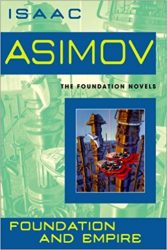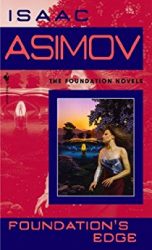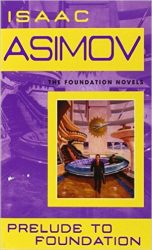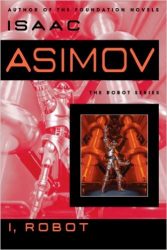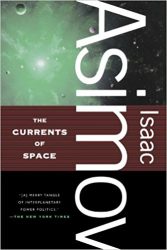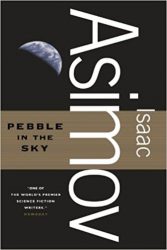Foundation Books in Order: How to read Isaac Asimov’s series?
I should probably have used the title ‘How to read Isaac Asimov’s Robot, Empire and Foundation series?’ but I didn’t want to make a title that was just too long. So, let’s talk about the great Isaac Asimov and some of his most famous works.
What is the Foundation Series about?
The original Foundation Trilogy is one of the most celebrated works of science fiction. Originally, it was a series of eight short stories published in Astounding Magazine in the 1940s.
Everything starts in the future where the mathematician Hari Seldon has developed the concept of psychohistory that he used to predict the future, but only on a large scale. He foresees the fall of the Galactic Empire and, to ensure a favorable future for humanity, he gathers talented minds to become the foundation for a new society.
Soon, they found themselves facing hard choices that would determine the future or the end of Mankind. Asimov says that when he wrote ‘Foundation’, he had no idea he had begun a series of stories.
After the original Trilogy, he wrote new books and extended the universe with connections to the Robot Series and the Empire Series.
How to read the Foundation Books in Order ?
There is not a single and simple answer to that question. So, I’ll propose to you two alternatives for a Foundation Reading Order and you’ll do as you want.
Let’s start with my proposition, then with the one based on what Isaac Asimov wrote himself in the ‘Author’s Note’ of the Prelude to Foundation.
I. The original Foundation Trilogy in Order
Let’s be honest, it’s better to start with the best and the heart of the story. These three books compose the original trilogy.
- Foundation – The Galactic Empire has ruled supreme, but now it is dying. Only Hari Seldon, creator of the revolutionary science of psychohistory, can see into the future. To preserve knowledge and save mankind, Seldon gathers the best minds in the Empire – both scientists and scholars – and brings them to a bleak planet at the edge of the Galaxy to serve as a beacon of hope for a future generation. He calls his sanctuary the Foundation. But soon the fledgling Foundation finds itself at the mercy of corrupt warlords rising in the wake of the receding Empire.
- Foundation and Empire – The Foundation has survived the greed and barbarism of its neighboring warrior-planets. Yet now it must face the Empire. When an ambitious general determined to restore the Empire’s glory turns the vast Imperial fleet toward the Foundation, the only hope for the small planet of scholars and scientists lies in the prophecies of Hari Seldon.
- Second Foundation – The story starts after years of struggle, the Foundation lies in ruins, but it is rumored that there is a Second Foundation hidden somewhere at the end of the Galaxy, established to preserve the knowledge of mankind through the long centuries of barbarism. The fate of the Foundation rests on young Arcadia Darell, only fourteen years old and burdened with a terrible secret.
II. The prequels and sequels of Foundation in Order
It’s a bit like Dune. First, you continue with the sequels and then you’ll go back to the start. Why? Because the two prequel books kind of change your perspective, but you’ll have a better appreciation for the beginning you know where everything is going. And Asimov wrote them knowing exactly where the story was going, so it’s better IMHO to have the same knowledge, in a way. That’s my take, and that’s why I’ll recommend you to follow Asimov’s chronology if you don’t agree.
- Foundation’s Edge – The first sequel to the original trilogy. At last, the costly and bitter war between the two Foundations had come to an end. The victors return to Hari Seldon’s long-established plan to build a new Empire. Now the two exiled citizens of the Foundation set out in search of the mythical planet Earth and proof that the Second Foundation still exists. Soon representatives of both the First and Second Foundations will find themselves racing toward a mysterious world called Gaia and a final shocking destiny at the very end of the universe.
- Foundation and Earth – Councilman Golan Trevize is wondering if he was right to choose a collective mind as the best possible future for humanity over the anarchy of contentious individuals, nations, and planets. To test his conclusion, he decides he must know the past and goes in search of legendary Earth, all references to which have been erased from galactic libraries. The societies encountered along the way become arguing points in a book-long colloquy about man’s fate, conducted by Trevize and traveling companion Bliss, who is part of the first world/mind, Gaia.
- Prelude to Foundation – The first Prequel. It is the year 12,020 G.E. and Emperor Cleon I sits uneasily on the Imperial throne of Trantor. Hari Seldon has come to Trantor to deliver his paper on psychohistory, his remarkable theory of prediction. Little does he know that he has already sealed his fate and the fate of humanity.
- Forward the Foundation – As Hari Seldon struggles to perfect his revolutionary theory of psychohistory to ensure the survival of humanity, the great Galactic Empire totters on the brink of apocalyptic collapse.
III. The Robot Series in Order
As you may know, the Robot Series can be read separately from the Foundation Series and the Empire Series. As Asimov didn’t plan his series from the start, connexions came later. In that spirit, the Robot Series integrated the Foundation continuity after the first trilogy. As the Robot novels are really good, it’s a good follow-up if you didn’t already read them.
- I, Robot – Collection of Short Stories exploring the famous three laws of Robotics.
- The Caves of Steel – The first Robot novel. A millennium into the future two advancements have altered the course of human history: the colonization of the galaxy and the creation of the positronic brain. This is the story of an unlikely partnership between a New York City detective named Elijah Baley and R. Daneel Olivaw, a humanoid robot, who must learn to work together when a prominent Spacer is murdered under mysterious circumstances.
- The Naked Sun – On the beautiful Outer World planet of Solaria, a handful of human colonists lead a hermit-like existence, their every need attended to by their faithful robot servants. Detective Elijah Baley and the robot R. Daneel Olivaw are sent from the streets of New York to solve an incredible murder that has rocked Solaria to its foundations.
- The Robots of Dawn – Detective Elijah Baiey is called to the Spacer world Aurora to solve a bizarre case of roboticide. The prime suspect is a gifted roboticist who had the means, the motive, and the opportunity to commit the crime, but Baley and R. Daneel Olivaw must prove the man innocent.
- Robots and Empire – Solaria has been abandoned by its human population. Countless robots remain there. And when traders from Settler worlds attempt to salvage them, the robots of Solaria turn to killing, in spite of the Three Laws of Robotics. With Madam Gladia and D.G. Baley– the captain of the Settler traders and a descendant of the robots’ friend Elijah Baley –, the robots Daneel and Giskard travel to Solaria where they uncover a sinister Spacer plot to destroy Earth itself.
IV. The Empire Series
And now, The Empire Series. Not as good as the two others are, not as connected as the two others are, and mostly optional in that regard. Those books can be read independently from one another.
To get back to the Foundation discussion, the Empire novels take place before the Foundation prequels, but after the Robots series. The connexions with the Foundation universe are less strong than between the other two series. In fact, it’s pretty optional, but if you want more and don’t mind weaker stories, those we’ll do.
- The Currents of Space – High above planet Florinia, the Squires of Sark live in unimaginable wealth and comfort. Down in the eternal spring of the planet, however, the native Florinians labor ceaselessly to produce the precious kyrt that brings prosperity to their Sarkite masters. Rebellion is unthinkable and impossible. The Trantorian Empire, whose grand plan is to unite all humanity in peace, prosperity, and freedom, has allowed the oppression to continue. Living among the workers of Florinia, Rik has been abducted and brainwashed. As his memories begin to return, Rik finds himself driven by a cryptic message he is determined to deliver: Everyone on Florinia is doomed, the Currents of Space are bringing destruction.
- Pebble in the Sky – One moment Joseph Schwartz is a happily retired tailor in 1949 Chicago. The next he’s a helpless stranger on Earth during the heyday of the first Galactic Empire. Earth, he soon learns, is a backwater, just a pebble in the sky, despised by all the other 200 million planets of the Empire because its people dare to claim it’s the original home of man. And Earth is poor, with large areas of radioactivity ruining much of its soil – so poor that everyone is sentenced to death at the age of sixty. Joseph Schwartz is sixty-two.
- The Stars, Like Dust – Biron Farrell was young and naïve when a radiation bomb planted in his dorm room changed him from an innocent student at the University of Earth to a marked man. He soon discovers that many light-years away, his father, the highly respected Rancher of Widemos, has been murdered. Stunned, grief-stricken, and outraged, Biron is determined to uncover the reasons behind his father’s death and becomes entangled in an intricate saga of rebellion, political intrigue, and espionage.
Isaac Asimov suggested reading order:
As I wrote before, Asimov didn’t know that the Foundation Series would become that big and that he was going to connect the series to Robot and Empire. So, in the ‘Author’s Note’ at the beginning of Prelude to Foundation, he offered his own reading order – a chronological order, to be precise.
- I, Robot
- The Caves of Steel
- The Naked Sun
- The Robots of Dawn
- Robots and Empire
- The Stars, Like Dust
- The Currents of Space
- Pebble in the Sky
- Prelude to Foundation
- Forward the Foundation – It was not on Asimov’s list as it had not been written yet, but it’s in the right place.
- Foundation
- Foundation and Empire
- Second Foundation
- Foundation’s Edge
- Foundation and Earth
—
If you like our article about the Foundation reading order, don’t forget to bookmark it! And if you want more ambitious and entertaining Sci-Fi, take a look at the Ender’s Game Series.

